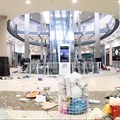
Source: © 123rf
123rf Supply chain or distribution failure made the top 10 risks at number six in Aon’s latest
Global Risk Management Survey when it comes to events such as elections
With more than 64 countries holding elections, it is no surprise that 2024 has been dubbed the election year.
In South Africa, there are concerns around the heightened risk for civil unrest and riots in the run-up, and even post-elections, with the riots of July 2021 a stark reminder of how quickly a match can explode into a multi-billion rand economic catastrophe and reputational disaster.
Commercial and corporate businesses must embrace a proactive stance towards risk management, business continuity and insurance.
Strengthening supply chains, enhancing security measures, conducting thorough risk assessments and maintaining up-to-date insurance policies are all strategies that can mitigate the impact of any upheaval.
Revisiting and revitalising crisis management plans, particularly business continuity processes and crisis communication will also prove invaluable.
By taking proactive measures, businesses can position themselves to navigate through uncertainty with resilience and confidence.
Roelof van den Berg 8 May 2024
Risk assessments
Identifying and understanding the potential ramifications of these disruptions is crucial from a risk management perspective.It starts with thorough risk assessments, identifying vulnerabilities in processes, operations and supply networks.
Key pressure points include:
- Supply Chain
“It is crucial to understand what risks are in the supply chain of a business and where business operations and income streams can be negatively impacted when production and distribution are delayed or disrupted.
“Today, supply chain risks involve the availability of talent, the ongoing solvency of critical suppliers, the ESG performance of a company’s supply chain and the increased intellectual property and cyber exposure triggered by shared supplier systems and processes,” says Danie Locke, senior risk consultant at Aon South Africa.
The fact that there are shared suppliers in most industries compounds these challenges, with a single event able to compromise hundreds of companies with the risk intensifying in regions prone to upheaval or unrest.
Mapping out any third-party suppliers or processes that could have an unintended effect on your business production line is key.
“The resulting complexity means that it is imperative to build visibility into the supply chain that extends beyond the most important suppliers and their geographic location and includes a keen understanding of suppliers’ capacity, utilisation levels and their dependency on other third parties.
"Profiling and quantifying the likely financial effects of losing a key supplier are critical to guide decisions around investments in resilience and adequacy of insurance cover,” Locke explains.
- Damage to property
The riots in Kwazulu-Natal (KZN) and Gauteng in July 2021 saw over R50bn in property damage and 340 lives lost.
The quantum of damage to property and commercial operations and equipment, and the impact on business continuity was near catastrophic, and many businesses simply did not recover.
It is important to check whether your business property policies provide sufficient cover and accurately reflect the replacement value of its assets.
“The property cover provided to a business is based on declared values, that need to reflect the property of the business and its operational risk in full detail.
“This will provide critical financial support in a worst-case scenario where the business may be forced to abandon operations during protest action, for example.
“Maintaining and regularly updating a fixed asset register is a good place to start when quantifying the risk that property damage poses to the business,” says Locke.
Assets and business Interruption are key concerns.
As a direct result of the July 2021 riots, Sasria reduced its coverage limits from R1,5bn for assets and business interruption to R500m.
For many large corporates, these limits are insufficient and will require additional cover in the form of a ‘riot wrap’ policy which provides additional coverage for loss of profit, contingent business interruption and material damage in excess of Sasria limits.
The riot wrap cover also provides cover for exclusions of war and civil war which are not covered under Sasria.
“Essentially, where combined material damage and business interruption values exceed Sasria’s R500m limit, the riot wrap policy will provide extended coverage in respect of the claim once the underlying Sasria (or primary limit) is eroded,” Locke explains.M
- Business continuity management
In the realm of business continuity management, particularly in the face of political or crisis-related situations, the imperative lies in the proactive updating and implementation of comprehensive crisis plans.
Nicolene Olivier, a global risk consultant at Aon South Africa, says these plans are not static documents but dynamic frameworks that evolve alongside potential risks.
Establishing strong communication processes will keep employees informed and updated during an event, as will the need to adopt robust security standards and provide training on crisis management and the company’s emergency procedures such as evacuation plans.
Central to this approach is crisis management, which serves as a protective shield for the organisation's reputation and brand integrity, and the safety of employees.
“The cornerstone of effective crisis management is communication, both internal and external. It's vital to maintain constant vigilance for any emerging threats or events that could disrupt operations.
“Regular and transparent communication with employees is essential, ensuring they are informed and prepared for any potential shifts that may occur, swiftly,” says Olivier.
A well-designed crisis management plan delineates the roles and responsibilities of various stakeholders, including designated teams for communication, legal, IT, HR and more.
These teams form the backbone of a 24-hour operational centre, ready to respond decisively to any unfolding situation. “Coordination among these teams is paramount, from ensuring the safety and well-being of employees to addressing legal and regulatory implications.
In the event of activating the business continuity plan, considerations extend beyond mere physical infrastructure to encompass aspects like cybersecurity, off-site operations and contingencies for events like power outages.
“Effective communication remains central throughout, with clear directives ensuring that every individual understands their role and responsibilities within the plan,” Olivier explains.
“Crisis communication, managed by designated spokespersons, serves as the public face of the company during turbulent times.
“All communication needs to be meticulously planned and executed through pre-prepared templates and contact lists, with a proactive approach ensuring that the organisation can navigate crises with agility and resilience, safeguarding its reputation and ensuring continuity of operations and safety of people,” she adds.
In these uncertain times, the ability to rebound, adapt and anticipate will be essential for businesses seeking to safeguard their interests and fulfil their commitments to stakeholders.
































